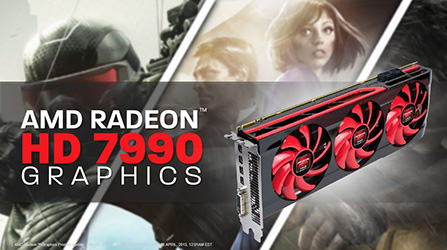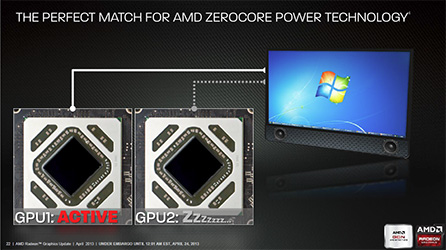 156
156
AMD Radeon HD 7990 6 GB Review
The Card »Introduction

Today, AMD launched its reference Radeon HD 7990 dual-GPU graphics card codenamed "Malta". The company's Radeon HD 7900 series preceded NVIDIA's high-end GTX 600 series by three months, yet NVIDIA was, with the launch of the GeForce GTX 690 close to a year ago, the first of the two to launch a dual-GPU graphics card based on its high-end silicon for this generation.
Part of the reason for things playing out as they did was NVIDIA's single-GPU flagship at the time, the GeForce GTX 680. Not only did it outperform AMD's Radeon HD 7970 GHz Edition, but it also made an attempt at a dual-GPU card by AMD futile. AMD's Radeon HD 7970 GHz Edition caught up with the GTX 680 in June, albeit at a significant power-draw cost that made a reference dual-GPU card all the more unfit for reference design treatment, since the GTX 690 showed near-perfect performance upscaling over the GTX 680 and exceptionally good power-draw. AMD's HD 7990, codenamed "New Zealand" on the company's roadmaps, was in jeopardy. The company did allow its board partners to come up with their own board designs that used a pair of HD 7970 GPUs, but those cards usually required three power connectors and triple-slot cooling solutions. AMD's 2012 clearly didn't end as well as the company had hoped for, at least in the extreme segment. By the turn of the year, AMD dropped hints that it hadn't given up on the reference HD 7990, adding that efforts to make this summer's high-end GPU segment interesting were well on their way.
The Radeon HD 7990 we have with us today is a far cry from the amp-guzzling "New Zealand" cards of 2012, so much so that AMD codenamed it "Malta." It makes do with a dual-slot cooling solution and draws power through two instead of three power connectors. It uses a pair of 28 nm "Tahiti" GPUs with all their physical components unlocked: the full complement of 2,048 stream processors, full 384-bit memory bus width, and clock speeds that don't look compromised. The core is clocked at a respectable 1.00 GHz, and its memory comes at 6.00 GHz. The card uses AMD's ZeroCore technology, which allows it to completely power down the card's second GPU outside of gaming.
Figuring out how the new HD 7990 "Malta" performs and whether its scaled down cooling and power connector requirements come at a cost will be a fascinating challenge. The card itself costs $1000 and will be available in stores within roughly two weeks.
| Radeon HD 7970 | HD 7970 GHz Ed. | GeForce GTX 680 | GeForce GTX 590 | GeForce GTX Titan | GeForce GTX 690 | Radeon HD 7990 | |
|---|---|---|---|---|---|---|---|
| Shader Units | 2048 | 2048 | 1536 | 2x 512 | 2688 | 2x 1536 | 2x 2048 |
| ROPs | 32 | 32 | 32 | 2x 48 | 48 | 2x 32 | 2x 32 |
| Graphics Processor | Tahiti | Tahiti | GK104 | 2x GF110 | GK110 | 2x GK104 | 2x Tahiti |
| Transistors | 4310M | 4310M | 3500M | 2x 3000M | 7100M | 2x 3500M | 2x 4310M |
| Memory Size | 3072 MB | 3072 MB | 2048 MB | 2x 1536 MB | 6144 MB | 2x 2048 MB | 2x 3072 MB |
| Memory Bus Width | 384 bit | 384 bit | 256 bit | 2x 384 bit | 384 bit | 2x 256 bit | 2x 384 bit |
| Core Clock | 925 MHz | 1050 MHz | 1006 MHz+ | 607 MHz | 837 MHz+ | 915 MHz+ | 1000 MHz |
| Memory Clock | 1375 MHz | 1500 MHz | 1502 MHz | 855 MHz | 1502 MHz | 1502 MHz | 1500 MHz |
| Price | $400 | $440 | $420 | $750 | $1000 | $1000 | $1000 |
Apr 8th, 2025 01:27 EDT
change timezone
Latest GPU Drivers
New Forum Posts
- Kindly help in Identifying GPU and Suitable bios (9)
- AMD RX 9070 XT & RX 9070 non-XT thread (OC, undervolt, benchmarks, ...) (84)
- 12v lines 0 reads occansionally (3)
- Asus X670E Crosshair Crashes (7)
- 9070XT or 7900XT or 7900XTX (122)
- USB case with dual USB-C and dual USB-A (7)
- The coffee and tea drinkers club. (247)
- The easiest way to connect the BOOTSEL test metal terminal and the GND terminal.... (1)
- Anyone with true HDDs still around here? (337)
- is it worth using ssd with usb2? (12)
Popular Reviews
- The Last Of Us Part 2 Performance Benchmark Review - 30 GPUs Compared
- UPERFECT UStation Delta Max Review - Two Screens In One
- ASUS Prime X870-P Wi-Fi Review
- PowerColor Radeon RX 9070 Hellhound Review
- Upcoming Hardware Launches 2025 (Updated Apr 2025)
- MCHOSE L7 Pro Review
- Sapphire Radeon RX 9070 XT Pulse Review
- Corsair RM750x Shift 750 W Review
- Sapphire Radeon RX 9070 XT Nitro+ Review - Beating NVIDIA
- DDR5 CUDIMM Explained & Benched - The New Memory Standard
Controversial News Posts
- NVIDIA GeForce RTX 5060 Ti 16 GB SKU Likely Launching at $499, According to Supply Chain Leak (161)
- MSI Doesn't Plan Radeon RX 9000 Series GPUs, Skips AMD RDNA 4 Generation Entirely (146)
- Microsoft Introduces Copilot for Gaming (124)
- AMD Radeon RX 9070 XT Reportedly Outperforms RTX 5080 Through Undervolting (119)
- NVIDIA Reportedly Prepares GeForce RTX 5060 and RTX 5060 Ti Unveil Tomorrow (115)
- Over 200,000 Sold Radeon RX 9070 and RX 9070 XT GPUs? AMD Says No Number was Given (100)
- NVIDIA GeForce RTX 5050, RTX 5060, and RTX 5060 Ti Specifications Leak (97)
- Nintendo Switch 2 Launches June 5 at $449.99 with New Hardware and Games (92)

